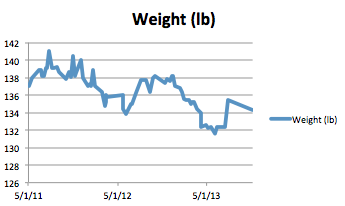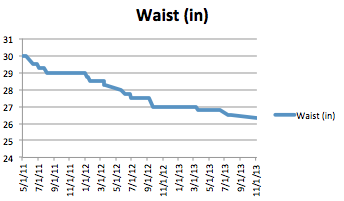Women, especially short women, seem to get the short end of the stick when it comes to fat loss. Despite seemingly-endless amounts of cardio and dieting, it is really @%&@!# hard for some women to lose fat, especially once they start to plateau.
You’re probably saying “duh they just need fewer calories,” and you wouldn’t be wrong, it’s just that the problem – and the solution – is a bit more nuanced than that.
A Case Study: Jane
Jane is 5’2 and 180 lbs. She was once 200 lbs or so, and through sheer brute force, lost 20 lbs from diet and exercise. She has unable to lose weight in the past few years; no matter how hard she tries, she just can’t seem to break 180. Due to cycles of dieting and binging, she hovers between 180 and 190 and feels like she’s forever doomed to remain within this weight range.
A look at calories burned and metabolism
Before we talk more about Jane’s particular situation, let’s take a look at how people burn a day’s worth of calories.
Total calories burned in a day = Resting metabolism + Thermic effect of intentional activity + Thermic effect of food + Thermic effect from non-exercise activity
Resting metabolism – The amount of calories that are required in order to maintain normal bodily functions, hormones, etc.
Thermic effect of intentional activity – Activities burned from moving around all day.
Thermic effect of food (TEF) – Calories burned from the process of eating your food and turning it into usable substrates.
Non-exercise activity thermogenesis (NEAT) – Calories burned from spontaneous activity that your body undertakes. Unfortunately, there’s not much you can do to directly impact NEAT, so we’re going to save this for another day.
In your average person, resting metabolism accounts for somewhere in the neighborhood of 70% of total calories burned in the day. Yep, that means most of your calories are spent just “staying alive,” even if you were to stay in bed all day. The thermic effect of activity comes in distant second, making up 15% or so.
Now, there seems to be great variation in one’s resting metabolic rate, some explainable, and some not. The large majority – 85% in fact – of all explainable variation can be explained by fat free mass. Stated another way, people with more fat free mass (or lean mass) have higher resting metabolic rates, and this accounts for most of the explained variation between individuals.
Why women get the short end of the stick
What happens when people over-consume calories with no additional exercise? Obviously, your body will happily store excess calories as fat. What most people don’t realize is that even without exercise, additional increases in fat mass also beget additional increases in lean mass as well.
Yes, this means that some people gain muscle by just stuffing their faces.
Interestingly enough, we can look to sumo wrestlers to see the extremes of how much mass one can accumulate through excess caloric consumption. Traditionally, sumo wrestlers don’t traditionally strength train and instead spend much of the day stuffing their faces. (Sounds like an amazing job, right?) This actually leads to a tremendous amount of lean body mass – more than bodybuilders.
Another study included a portion in which participants were overfed 1000 kcals for 100 days while doing nothing else. Those individuals gained 1 pound of muscle for every 2 pounds of fat. (By the way, do we have any doubt at this point that food is an incredibly anabolic substance? Again, these individuals were sedentary.)
So it looks like in some sedentary individuals, not all excess calories go towards adipose storage. Some goes towards the creation of lean mass.
But who benefits from this gloriously amazing side effect?
Unfortunately, in my experience looking at overweight, untrained clients, it only seems to be men. (In fact, there were no women in the aforementioned studies.) This may be because testosterone is a key player in determining whether excess calories are partitioned towards building muscle or adipose storage. In fact, there’s evidence to suggest that it is heavily dose dependent on testosterone.
And this is the crux of why women get the short end of the stick.
When men begin experience weight gain, some of this is dampened by the fact that additional calories are partitioned towards building muscle. Despite the weight gain, this additional muscle also increases his RMR.
The extent to which women receive this benefit is probably far less, if at all.
Let’s look at this a much more dismal way.
A 5’2 200-pound woman might eat like a 200-pound woman, but she burns calories like a 120-pound woman. Her excess weight could ostensibly add an additional caloric burn through exercise, but it’s likely that our subject is sedentary, as overweight, untrained individuals often are.
Back to Jane…
Let’s look at just how many calories Jane burns per day.
To estimate maintenance calories for my clients, I use the Katch-McArdle formula. Unlike other formulas, it takes lean mass into account when calculating RMR and seems to work pretty well.
One thing that’s not frequently discussed is just how high Jane’s (or someone like Jane) body fat percentage is. Whenever I ask women to estimate their body fat percentage, they will often self-report something around 30% max, perhaps 40%. Underestimating this value often leads to an overestimation in how many calories are required to maintain the same weight.
If we assume that in untrained, overweight women, fat free mass increases relatively little as weight goes up, we can actually back into Jane’s approximate body percentage. Looking at personal client data, untrained women usually start out at 1.3-1.5 lb/in. If Jane is 5’2, then she’d need to be about 50-55% body fat in order for this value to hold true.
People rarely guess that their body fat is this high, but in shorter, overweight women, it’s not particularly difficult to reach this range. Tying everything together, remember how we talked about how, unlike women, men accumulate muscle vis-à-vis a caloric surplus, leading to a dampening effect? If our assumptions hold true, then dampening effect acts as a body fat percentage ceiling.
Anyway, using the Katch-McArdle formula and a reasonable activity multiplier, this puts Jane’s maintenance calories at about 1900-2000 calories a day or so.
(Update: I just re-read Evelyn Kocur’s – who is absolutely brilliant by the way – article on a similar subject matter, and she seems to come to a similar conclusion.)
When someone like Jane comes to me, I always guess the following things to be true, and I’m right with eerily high accuracy.
- She’s a binge eater.
- She does a ton of cardio. This might actually be required to keep the weight off.
- She tries to eat a diet low in carbohydrates.
- Caloric consumption on non-binge days is alarmingly low.
Basically Jane is working with extremely slim margins. That, combined with the fact that it’s incredibly difficult for women to gauge linear, week-to-week weight loss, and you have someone who aggressively cuts carbohydrates, does long bouts of cardio, plummets their caloric output (relatively speaking), craves food insatiably, and inevitably develops a yoyo dieting pattern.
The concept of a weight loss “floor”
When I think about a client’s capacity to lose weight, I think of the concept of a “floor.” A client’s floor is the amount of weight that they can comfortably get down to before they start experiencing a bevy of stalls, hunger, and other batshit craziness.
The problem with Jane is that her floor is quite high compared to where she wants to be. It’s at 180 pounds. She could push further than that, but it would be unsustainable, as it would deplete certain finite resources – willpower, time, resources, etc.
When I see someone like Jane, my top priority is to lower her floor, and there are a few ways to go about this.
The first is that I get rid of the physiological reasons that cause her to binge eat, namely temporarily eliminating all cardio and raising caloric intake. I write more about this here.
The second thing that I do is combine resistance training with the maximum amount of carbohydrates level that will allow her to still continue losing fat, while raising her metabolism and undoing some of the damage caused by long bouts of dieting and cardio. In many cases, weight measurements stay the same or go up while waist measurements go down.
The process of building lean mass alone won’t do the trick to lose weight. As Evelyn also correctly alluded to in her post, the amount of calories burned per pound of additional lean mass is usually exaggerated.
What I have found, however, is that the combination of resistance training and increased carbohydrates tends to lower a client’s floor. This is because this processes increases their capacity to consume additional carbohydrates, and therefore, more calories. (Also, increases in leptin, T3, and all the other fun stuff associated with maintaining a high carbohydrate intake.)
The most important thing to realize is that this process takes a very long time. Remember, Jane is at 55% body fat, and this is not something that will improve over night.
Here is some data from one client of mine who could not lose weight at 137 lbs and stalling out for months at a miserable 1,000 calories/day. (This client is particularly interesting because of the reliability of her data. She’s the type who is OCD about reporting and always hits macros.)
As you can see, in the last 2.5 years, she’s only lost 6 lbs, but that wasn’t the point. The point was to continue to lose fat while lowering her floor. You can see a remarkable reduction is waist measurements, even if her weight has been relatively similar.
The best part? She’s consuming nearly twice as many calories as when she started. You can bet that the next time she decides that she wants to absolutely focus on fat loss, she’ll fly past her previous low weight with ease.
READ THIS NEXT: Weight Loss For Beginners


